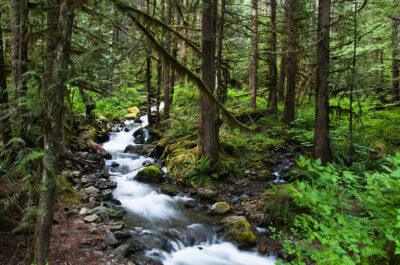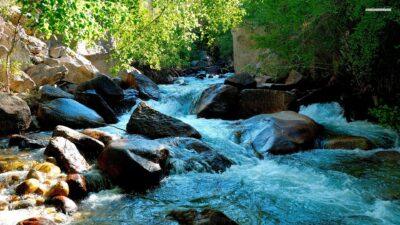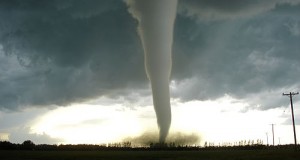We all know that we need water to survive. Perhaps we even buy elaborate water purification systems or stockpile water.
But what do you do when you’re out in the wilderness, thirsty and lost, and need water to fill your bottles? Or, even worse, out in the wilderness in an arid area of the country? How can you find water then?
Hopefully you’ve got a topographical map that has water sources marked. But you can’t necessarily count on that. You need to know how to read the land as well, so that you can tell where to find water, even if you don’t have a map. Look around you, and the land will tell you where the water is.
1. Go Downhill
The first thing to do is head downhill. Water, following the laws of gravity, will always flow downward. Not only that, but it will always look for the easiest way to go downhill. Look around you. How is the land sloping? Is there a valley or canyon that water is likely to flow through? You’re much more likely to find water in the depression where two mountainsides or two hillsides come together, than you are on the hillside itself.
It may take a while, but if you are traveling downhill, you’ll eventually get to water. Watch out for dehydration, though. If you are in arid terrain, you will be better off traveling at night and hiding out in the shade during daylight hours. Walking in the direct sun will cause you to sweat even more, dehydrating you faster.
2. Watch for Hidden Basins
As you are walking downhill, keep your eyes open for hidden catch basins. You might come across one in a hidden spot in a valley. It’s not uncommon for the terrain to cause small ponds in catch basins, especially if the valley is rock, rather than dirt. Water won’t absorb into the rock as easily. There is even a possibility of finding hidden water basins in the desert, if there is rock to hold the water.
Ultra-Efficient Water Filter Fits In Your Pocket!
Also, watch for indicators of catch basins. If you see a dead tree with a trail of ants going up it, there’s a good chance that there is water in a hollow of that tree. Insects, like ants and bees, need water, and won’t travel far from a good reliable source.
Hidden basins may not be easy to see, as the same terrain features that make them possible also make them hard to find. At the same time, they may be hidden by foliage, preventing you from seeing them easily, which brings us to our next point …
3. Look for Green
Plants need water and (obviously) can’t travel to where it is. So instead, they grow in places where they can find a ready supply. Look for plants as an indicator of water. A line of plants going across an otherwise barren plain indicates a watercourse, even if it is dry at the moment. Follow that watercourse, looking for pools of water that outlast the stream.
Plants also contain a lot of water, so you can often draw water out of the plants. Cacti can be cut open and placed in a solar still to draw water out of them. The same can be done with leafy plants, although you can accomplish the same thing by covering a branch with a plastic bag. The sun will warm the air in the bag, causing water to evaporate out of the leaves, which will condensate on the inside of the bag.
Springs can pop up in the most unlikely of places. Basically, a spring is a place where underground water comes to the surface through a crack due to the pressure underground. A spot of green on a mountainside, where the rest of the mountain is rocky or bare, most likely indicates a spring.
4. Follow the Animals
Animals need water and can smell it, giving them an advantage over us. Typically, these animals will water in the morning, around sunrise and at dusk. If you find animals moving at these times of day, you can be fairly sure that they are moving toward water.
The Secret To Starting Fires In Even The Most Extreme Conditions
You don’t have to find animals, though; it’s enough simply to find their trails. Any animal trail that is going downhill is most likely going to a water source. Just follow the trail. Since most animals don’t travel very far during a day, in all likelihood you’ll find water within a couple of hours.
5. Be Ready to Dig
There are many watercourses or ponds that are only filled when it is raining or perhaps only in the rainy season. However, that doesn’t mean that all is lost. There’s a good chance that there is still water underground, even if there is none on the surface.
Look for muddy areas, especially those that are lower down, such as the bottom of a small pool. The water will be closer to the surface in those areas, so it will be easier to obtain. Dig a hole and wait, allowing the water to seep into the hole. The deeper the hole is, the better a chance of getting water out of it.
Don’t Forget to Filter
Once you’ve found your water, always be sure to purify it, no matter how clear it looks. Muddy water obviously needs filtering. Clear water may not have any sediment, but it can still have microscopic pathogens in it. Those are by far the more dangerous.
If the water is muddy, pre-filter it with a cloth before running it through your water filter. The sediment in the water can block your filter, rendering it useless way too soon. By pre-filtering it with cloth, you can remove most of the sediment, ensuring that your filter element will last longer for filtering out the more dangerous pathogens.
What would you add to this list? Share your water-finding tips in the section below:
 Off The Grid News Better Ideas For Off The Grid Living
Off The Grid News Better Ideas For Off The Grid Living







